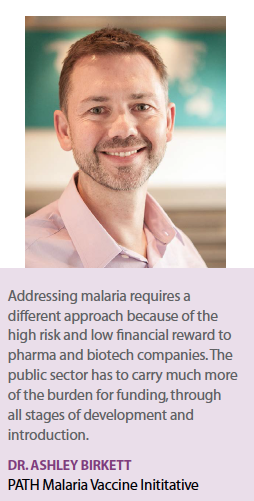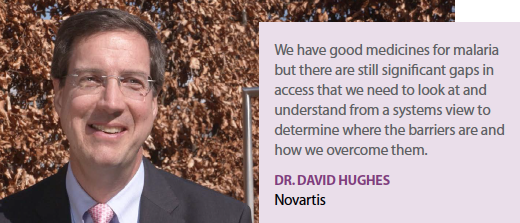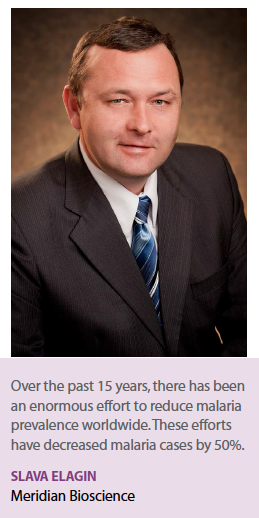Despite the successful deployment of multiple interventions against malaria, there were an estimated 212 million cases of malaria and an estimated 429,000 malaria deaths worldwide in 2015, according to the most recent figures from the World Health Organization.
Malaria is a mosquito-borne disease caused by a parasite. People with malaria often experience fever, chills, and flu-like illness. Left untreated, they may develop severe complications.
Malaria is caused by parasites (Plasmodium falciparum and Plasmodium vivax) transmitted to people through the bites of infected mosquitos. Artemisinin-based combination therapies (ACTs) are currently the standard of care against falciparum infections. Yet, rising resistance to artemisinin is seen.
 The development of effective malaria vaccines has been a major goal of the malaria research community for many decades. Experts say a vaccine is needed because current prevention methods are only partially effective.
The development of effective malaria vaccines has been a major goal of the malaria research community for many decades. Experts say a vaccine is needed because current prevention methods are only partially effective.
“The most efficient way to prevent any infectious disease is with a vaccine," says Stephen Hoffman, M.D., CEO, Sanaria. “The human infectious diseases that have been eliminated or dramatically reduced — smallpox, polio, and measles — were controlled with a vaccine.
“The magnitude of the problem is so huge that it’s very difficult to get to the end of the game with the current measures," Dr. Hoffman continues. “It doesn’t mean it can’t be done, but malaria is most intense in areas that are relatively poor and don’t have health delivery systems as good as we might have here in United States."
More than 40% of the global population is at risk of malaria, according to a World Health Organization (WHO) malaria fact sheet and World Bank estimates. The WHO says around 214 million malaria cases were reported in 2015, leading to 438,000 deaths worldwide. More than 70% of these deaths were among children under 5 years of age.
Sub-Saharan Africa accounts for the highest share of global malaria burden, with around 89% of malaria cases and 91% of malarial deaths in 2015. The high impact of this life-threatening disease is influencing governments across various countries, companies, investors, and nonprofit organizations to contribute toward curbing the spread of this disease.
In the past 15 years, there have been enormous efforts to reduce worldwide malaria prevalence, says Slava Elagin, executive VP, research and development, Meridian Bioscience.
He points to the Bill & Melinda Gates Foundation’s efforts for a malaria-free world, which has contributed $2 billion in grants to combat malaria, as well $1.6 billion to the Global Fund to Fight AIDS, Tuberculosis and Malaria, which provides about 50% of international funding for malaria control worldwide.
“Controlling the mosquito population is one obvious approach," he says. “Developing better informatics tools to understand where malaria epicenters are is a second approach that could help. The third approach is to create tools that can detect people who have malaria but no symptoms to help prevent transmission of the disease from one patient to another."
 Another global effort to control malaria was launched in April. Leaders from governments, pharmaceutical companies, and charitable organizations convened at a five-day summit in Geneva to pledge new commitments to the collective efforts to control and eliminate neglected tropical diseases (NTDs).
Another global effort to control malaria was launched in April. Leaders from governments, pharmaceutical companies, and charitable organizations convened at a five-day summit in Geneva to pledge new commitments to the collective efforts to control and eliminate neglected tropical diseases (NTDs).
The summit coincided with the launch of the WHO’s Fourth Report on NTDs, showing transformational progress against these debilitating diseases, and a commitment by the United Kingdom to more than double its funding for NTDs.
Additionally, an April coalition of global health organizations has called on the G20 to provide leadership in combating pandemics, drug resistance, and major poverty-related and neglected diseases, which include drug resistant strains of HIV/AIDS, TB, malaria, diarrheal disease, and pneumonia.
The World Bank has estimated that, without additional resources, these diseases will push an additional 28.3 million people into poverty, increase global healthcare costs by $1.2 trillion, and cost low-income countries more than 5% of GDP by 2050.
Treatments are available for malaria, but many patients still don’t have access to the medications. In fact, a study done by researchers at the University of California, San Francisco, and published in April in The Lancet found that that just 20% of children younger than 5 received artemisinin-based therapies, which are effective for uncomplicated Plasmodium falciparum malaria infection.
Vaccine Research Efforts
Developing vaccines against parasites such as those that lead to malaria has its challenges. In fact, no vaccines are available against any human parasites.
“Parasites are much more complex than viruses and bacteria, where we have been relatively successful in developing effective vaccines; parasites have very complicated lifecyles," says Ashley Birkett, Ph.D., director of PATH’s Malaria Vaccine Initiative (MVI). “We don’t know precisely what type of immune response a vaccine needs to induce high efficacy and durable protection but significant progress is being made. In recent years, two independent vaccine approaches have been associated with high levels of efficacy (approximately 90%) in controlled human infection models conducted in the United States."
Therefore, researchers are optimistic that a vaccine can be developed to induce effective immune responses against the parasites that cause malaria.
This optimism is also fueled by progress of the most advanced vaccine: GlaxoSmithKline’s Mosquirix (RTS,S,). In July 2015, this vaccine received a positive opinion from the Committee for Medicinal Products for Human Use (CHMP) of the European Medicines Agency for children 6 weeks to 17 months of age. Mosquirix was developed to protect young children from malaria caused by Plasmodium falciparum.
RTS,S, which was developed in partnership with PATH MVI, is the first candidate vaccine for the prevention of malaria to have successfully completed a Phase III clinical trial. The trial was conducted between 2009 and 2014 through a partnership involving GSK, PATH MVI, and a network of 11 research sites across seven African countries.
Data from this trial demonstrate that over the first 18 months following three doses of RTS,S, malaria cases were reduced by almost half in children 5 to 17 months old at the time of first vaccination and by 27% in infants 6 to 12 weeks old.
At study end, four doses of RTS,S reduced malaria cases by 39% over four years of follow up in children, and by 27% over three years of follow-up in infants.
In areas with the highest malaria burden, more than 6,000 clinical malaria cases were prevented over the study period for every 1,000 children vaccinated.
 The efficacy of RTS,S was evaluated in addition to existing malaria control measures, such as insecticide treated bed nets, which were used by about 80% of the children and infants in the trial.
The efficacy of RTS,S was evaluated in addition to existing malaria control measures, such as insecticide treated bed nets, which were used by about 80% of the children and infants in the trial.
In April of this year, the World Health Organization announced that Ghana, Kenya, and Malawi will take part in a WHO-coordinated pilot implementation program that will make the malaria vaccine available in selected areas beginning in mid-2018.
The WHO pilot program will assess whether the vaccine’s protective effect in children 5 to 17 months old during Phase III testing can be replicated in real life. Specifically, the pilot program will assess the feasibility of delivering the required four doses of RTS,S, the vaccine’s potential role in reducing childhood deaths, and its safety in the context of routine use.
One goal of the pilot program is to gather more information on the ability of the vaccine to prevent severe malaria and mortality, Dr. Birkett says.
“In the Phase III trial, relatively few children experienced severe malaria," he says. “The healthcare infrastructure associated with the Phase III trial was exceptional, which is not what you typically see in areas of Africa most impacted by malaria. The trial doesn’t give us an accurate sense of how the vaccine would actually work in terms of preventing severe malaria and death in a real-world setting. With a pilot implementation, as opposed to a controlled study, the idea is to generate a more accurate assessment of the potential impact of the vaccine in a real-world setting."
Dr. Birkett says the pilot will also aim to generate more safety data.
“As is typical with vaccines evaluated in clinical trials, there are safety signals from the Phase III study that need to be followed up as the vaccine is administered to more children," he says.
PATH MVI has partnered with GSK for more than a decade on the development of this vaccine, which required building infrastructures at the sites where the clinical trials were conducted, Dr. Birkett says.
“The data generated from this pilot could set the stage for a broader policy recommendation for this vaccine going forward," he says.
“Current data suggests this vaccine will most likely have the greatest public health impact in medium-to-high transmission settings. For about 10 years, we’ve worked closely with malaria endemic countries on a tool we call the Malaria Vaccine Decision-Making Framework to help ensure countries considering the introduction of a malaria vaccine take into account all the information necessary to make the most informed decision possible."
Two of the WHO’s independent advisory groups — the Strategic Advisory Group of Experts (SAGE) on Immunization and the Malaria Policy Advisory Committee (MPAC) — are jointly reviewing the evidence base for RTS,S and they will make a joint policy recommendation for how it might be used, says a spokesperson for GSK.
Following the WHO policy recommendation, GSK will also submit an application to the WHO for pre-qualification of RTS,S.
A pre-qualification decision is used by the United Nations’ agencies and other large scale public procurement agencies to help inform vaccine purchasing decisions.
The GSK spokesperson says once a WHO pre-qualification is granted, GSK will apply for marketing authorization in countries in sub-Saharan Africa on a country-by-country basis.
Sanaria is another company working to developing a vaccine against malaria. Sanaria PfSPZ-Vaccine is being developed against Plasmodium falciparum. It is composed of live, radiation-attenuated purified, cryopreserved malaria parasites, which are administered in an injection.
In February, Sanaria announced results of a study done in Mali that found protection was sustained for the 24 weeks of the study. In the Mali study, five doses of PfSPZ vaccine were administered to 44 subjects and saltwater placebo was given to 44 subjects. Volunteers were followed for six months through the subsequent rainy season to determine the presence of malaria parasites in the blood. The vaccine was 52% protective.
Another study of Sanaria PfSPZ-Vaccine was conducted by a team of clinical investigators at the Naval Medical Research Center and Walter Reed Army Institute of Research. This study found that that the vaccine protected against Plasmodium falciparum malaria when clinical trial participants were exposed to two strains of parasites.
Furthermore, protection was achieved with just three doses of the vaccine and against a strain of parasite similar to one in the vaccine for at least 24 weeks. This Phase II trial included 69 volunteers, 19 to 45 years old. Forty-five volunteers received at least one dose of the vaccine, 24 volunteers were control subjects.
About 2 billion sporozoites (PfSPZ) produced by Sanaria have been injected in clinical trials. Dr. Hoffman says the company’s manufacturing of the vaccine is unique.
“Parasites are much more complex than viruses or bacteria," he says. “Our manufacturing process is unique in that we are manufacturing a whole parasite and using mosquitoes as the bioreactor."
Dr. Hoffman says the company is currently developing the protocol for a Phase III study, which will be conducted in the United States, Europe, and Africa. In September 2016, Sanaria received FDA Fast Track designation for its preventive PfSPZ-Vaccine for malaria.
Malaria Treatment and Research
Effective malaria drugs are available, but they may be losing their effectiveness in some places as malaria-causing parasites have developed resistance. Industry experts say changes in mosquito behavior and insecticide resistance are increasing concerns about drug resistance.
“The plasticity of the mosquito and the Plasmodium parasite has led to increasing resistance to antimalarial medicines and insecticides," says Andrzej Piotrowski, M.D., Ph.D., medical monitor, KCR. “Resistance to artemisinin-based combination therapies has been detected in Southeast Asia – Greater Mekong subregion. The spread of these strains to Africa or the Indian subcontinent could be catastrophic."
Artemisinin-based combination therapies are the treatment of choice for uncomplicated malaria in sub-Saharan Africa.
“However, their administration over a three-day period is associated with treatment adherence problems resulting in reduced effectiveness of currently recommended antimalarials," Dr. Piotrowski says. “The development of a single-dose combination therapy would constitute a breakthrough in the control of malaria. This innovative treatment approach would simultaneously close the effectiveness gap of the current three-day regimens. It would also revolutionize population based interventions in the context of malaria elimination campaigns."
Dr. Piotrowski says new lines of drugs must be explored before existing drugs lose their efficacy.
The development pipeline for malaria has never been stronger, with promising new tools to detect, treat, and prevent the disease, such as innovative diagnostics, medicines, vaccines, vector control products, and improved mechanisms for surveillance and response.
There are at least 25 projects in the global malaria vaccine pipeline as well as 47 medicines and 13 vector control products. There are also several next-generation diagnostic tools and reference methods currently in development, with many expected to be introduced in the next decade.
“The development and deployment of these tools, supported by strategies that ensure rapid uptake in target populations, enhanced mechanisms for information management, surveillance, as well as continued financial and political commitment are all essential to achieving global eradication of malaria," Dr. Piotrowski says.
He says in Africa, resistance has been detected against two or more insecticides in two-thirds of those countries where malaria is endemic. Up to 80% of infections are asymptomatic, and Plasmodium vivax parasites remain dormant for months or even years after initial infection.
“The causes of drug resistance are generally mutations or changes in the copy number of genes relating to the drug’s parasite target," he says.
Leaders from Novartis — whose Coartem is recommended by the Centers for Disease Control and Prevention (CDC) as first-line treatment for acute, uncomplicated malaria infections — say they are monitoring the use of the drug to assess resistance.
“These data are helpful when we do our clinical trials of new compounds; we are able to put the information into context and understand the target profile that we are looking for because we understand what works and where there might be gaps," says David Hughes, M.D., global program head of anti-infectives development, Novartis.
Novartis currently has two malaria programs in development. KAF156, currently in Phase II, is the first compound from a novel class of antimalarials known as imidazolopiperazines. Nonclinical and clinical data suggest KAF156 has the potential to be effective against infections resistant to all currently available antimalarial drugs.
The company is developing KAF156 with support from Medicines for Malaria Venture, in collaboration with the Bill & Melinda Gates Foundation.
In September 2016, Novartis published proof-of-concept study results in the New England Journal of Medicine showing that KAF156 demonstrated activity against both Plasmodium falciparum and Plasmodium vivax malaria, including artemisinin-resistant parasites. Dr. Hughes says both compounds are beginning Phase IIb programs, primarily in Africa.
The trial for KAF156 is an adaptive trial in several cohorts of patients to assess dosing in adults and children. This trial will also evaluate KAF156 in five sites in Asia to assess treatment of resistant infections.
“Both of these drugs involve novel classes of medicines and novel mechanisms of action," Dr. Hughes says. “These medicines came out of our high throughput screening efforts in partnership with academic and other partners to see what works against malaria parasites."
Development of KAF156 and KAE609, the company’s second program, is a joint research program with the Novartis Institute for Tropical Diseases (NITD), the Genomics Institute of the Novartis Research Foundation, and the Swiss Tropical and Public Health Institute, supported by the Wellcome Trust, the Singapore Economic Development Board, and Medicines for Malaria Venture.
Dr. Hughes stresses the partnerships Novartis has are not only to develop new medicines for malaria, but also to make sure they are distributed to those who need them. For example, the NITD, part of the Novartis Institutes for BioMedical Research (NIBR), was set up as a public-private partnership between Novartis and the Singapore Economic Development Board.
In December the company launched SMS for Life 2.0, which builds on the SMS for Life program launched by Novartis in 2009, which used cell phones to manage stock-outs of malaria medicines in more than 10,000 healthcare facilities in sub-Saharan countries. The new program will now add smartphones and tablet computers to address key operational challenges at peripheral healthcare facilities in Kaduna State, Nigeria. (PV)


















